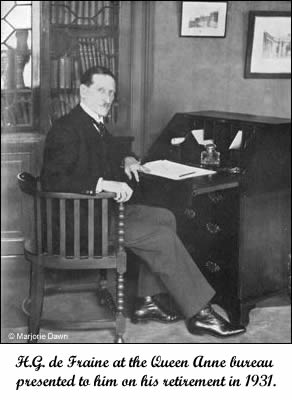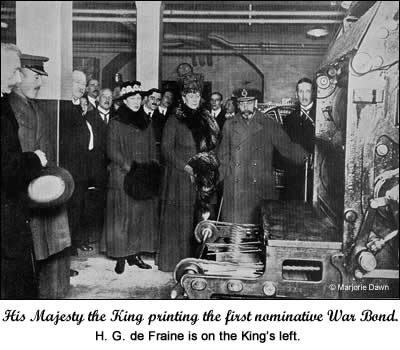Herbert George de Fraine spent 55 years at the Bank of England and his recollections of life with the bank were published after his death at the age of 88, by his daughter in “Servant of This House” in 1960.
From its earliest beginnings the bank has been referred to as ‘the House’ rather than ‘the Bank’ by the employees, perhaps because its first permanent premises were built on the site of the house belonging to its first Governor.
Herbert began his career with the Old Lady, as he also called her, in 1886 as a boy of sixteen, and for over two years spent all day counting the bank notes removed from circulation. Some sixty thousand were returned each day and every one had to be examined, placed in its appropriate section with the signature torn off and then entered in a ledger by hand, before being bundled for burial in the vaults, where it stayed for seven years before being burnt. But not before, Herbert says, the balance had been checked, for the value of the notes withdrawn had to match the value of record of those handed over the counter, and the young men were kept back until everyone’s lists tallied. It sounds a tedious and boring job, but reminiscing later Herbert thought himself very lucky to have had it. The clerks were always appointed on the recommendation of one of the twenty six directors, or were sons of clerks already working for the bank. Herbert’s father knew one of the directors and asked him for the nomination. As the director died shortly afterwards Herbert thought himself doubly lucky.

His reminiscences show that he was someone who was interested in everything around him. He recalls travelling by horse tram and the dirt and mud underfoot which necessitated having to use clothes and shoe cleaning brushes before starting work. He was earning £42 a year at first, which he says had to be supplemented by his father, but was nevertheless, “princely in comparison with the current wage for a farm labourer”. But, as he adds, he had to pay for lodgings and clothes suitable for working in the bank – which included a black silk hat, which had to be refurbished several times a day in bad weather (that is, Herbert had to take it to the hatter who smoothed it with hot irons, for free). In Summer the silk hat was changed for a straw one, but the rest of his outfit stayed the same. He wore a dark blue overcoat with a black velvet collar, compulsory gloves, and carried either a walking stick or an umbrella. In the Bank he had to wear trousers without turnups, black button boots and a tailcoat over a starched shirt with a stiff white collar and cravat. The whole outfit was set off with a gold watch-chain across the waistcoat. He notes that one could smoke a cigar, or even a cigarette in the street, but a pipe was quite forbidden. His book is a mine of information for social historians.
After a year his pay was raised to £54 and he was given a week’s holiday, and at the end of the second year he was raised to £80, which was a really good salary for a young man at the time. Even so, although he became engaged to be married in 1890, they were not able to marry for another seven years and his fiancée earned her living as a governess, which was, as Herbert remarks, the only respectable occupation for women but extremely poorly paid. He spent his spare time sightseeing at first, but was soon going to music halls and the theatre, as well as riding the new safety bicycle he bought with his first overtime payment for volunteering to work in the evening for a special job.
Discipline in the Bank was very strict. Talking as they worked was forbidden, visits to the WC were timed and they were allowed exactly thirty five minutes for lunch. This formality extended to personal relations and Herbert says he never called anyone by his Christian name however friendly they became.
He became fascinated by the working of the Bank and within three years he managed to pass the necessary exam to become a full employee with pension rights against stiff competition. On his promotion Herbert became ‘unattached’, which meant he could be sent anywhere to work, which gave him an excellent knowledge of the various workings of the Old Lady. The book of his reminiscences gives many details of the various departments of the Bank and the ways in which the Old Lady controlled things through three people; the Chief Accountant, the Chief Cashier and the Secretary. For a time he was in the Shutting Office, so called because it was were the books were shut before a dividend was declared, and the payment warrants made out. As he says, when it was not time to declare a dividend there was really no work to be done and he found that it was quite a leisurely affair.
He spent time dealing with stockbrokers, buying and selling stock, and in the dividend payment office where the cashiers were so busy that they had to work in relays on the pay-out days, for people expected to receive cash in their hand. The Old Lady thought payment by warrant was risky and it was only done on request.
Having sampled several different sides of the Bank, Herbert was given the choice of working on the stock or the cash side of the Old Lady for the rest of his career. He chose the cash side because there was a greater chance of becoming a Cashier in the Bank’s Treasury, which had a higher final salary and thus an increased pension. He says he came to realise that actually promotion in the Bank depended more on string-pulling or on catching the eye of someone with influence than on hard work.
He worked in the Clearing House which was where representatives of other banks would come together physically to exchange their cheques and bills of exchange with each other and with the Old Lady. As he mentions, everything had to be entered, scrutinised and computed by hand. As he became older and more experienced, Herbert was sent round a district to distribute and collect bills of exchange, dividends, cheques and warrants from various businesses, and at one time was collecting from Government offices as well as the small private banks, and once from royalty at Marlborough House.
In 1894, women graduates were recruited into the Bank as clerks, with some as typists on the new typewriters, and they were given a separate department with a separate entrance and exit from the men. Herbert says they were not allowed even to catch a glimpse of a male nor enter an office where one might be present because, “behind the closed doors lurked horrible males with hairy goat legs waiting to pounce on them as they passed”. They had their own Superintendent in Janet Elizabeth Hogarth, who later wrote about the tedium of their work. Even today, the Bank is said to try to regulate the female employees and recently issued a memo on the appropriate dress at work saying that they must wear make-up and high heels. Although Herbert is not always clear it seems that around the same time, the young men dealing with returned bank notes were replaced by young girls of the same age who were found to be more dextrous than the men, and Herbert also has a reference to girls aged from fourteen to sixteen replacing the boys in the printing shop, where they worked as messengers distributing the paper. The boys had been encouraged to take up apprenticeships afterwards, but he does not say whether this applied to the girls.
The Old Lady was compassionate to her employees and when Herbert was ill with chronic bronchitis and then found to suffer from asthma, she paid for him to go to Madeira to recuperate for a month. He paints a horrifying picture of people there suffering from advanced tuberculosis, which as he says many did not believe was infectious, but he met with a doctor who warned him against too much contact and he decided to leave early and returned home, where the Old Lady set him on light duties clearing the desk of someone who had just died of TB, which he found disconcerting.

In 1911 after being Deputy Principal for four years of the Bills Office where he had begun his career, Herbert was made Principal of the Printing Department responsible for overseeing the printing of all the bank notes, warrants and other papers the bank issued. This suited Herbert, his father was the printer and publisher of the Bucks Herald in Aylesbury, and Herbert had always been interested in engineering and machines and he says he devised various improvements in the working of certain areas. The job included wide ranging responsibility for much of the housekeeping of the Bank, the buying of fuel and other supplies, and overseeing much of the maintenance of the building and equipment.
Herbert encouraged many recreational activities at the printing works, they had their own sports ground, their own orchestra and choir, all kinds of clubs from chess, to the rifle club, to the ramblers, and the girls had a gymnasium class for which his wife played the piano.
During the 1914-1918 war he was ordered in great secrecy, and working with only two others under lock and key, to supply forged documents and papers which were delivered to the Admiralty for, he guessed, distribution to the Secret Service agents working against the Germans.
After the war he oversaw the building of the new printing works in the old St Luke’s Lunatic Asylum in the 1920s, which continued as the Bank’s printing works until the 1950s. When in charge of the printing works he had been partly instrumental in some research into phthisis, a disease rife amongst printers who were inhaling the silica dust from the type, and he installed and implemented the use of large scale permanent vacuum cleaning of the workshops in the new building, which became general practice in similar workplaces. At the time, the works were producing a weekly output of between eleven and twelve million of plate-printed notes, each of which took some forty days to go through the various process. This was just in notes; the works were also printing many other items, including at one time pension books, postal orders and pay records for the services, as well as the necessary warrants and dividend sheets.
By 1928 the works were fully working with the latest machinery. This was the climax of Herbert’s career, although he did not retire until 1931 when work was stopped for an hour (as he says at a cost of £1 a minute!) to say farewell with a grand party, including entertainment, put on in his honour by the various clubs and societies and presentations of all kinds, including the Queen Anne writing desk at which he was photographed.
(He was second cousin to Ethel Louise de Fraine and second cousin once removed to both John de Fraine, and George Henry de Fraine, who have all appeared in the Magazine previously, and my grandfather’s younger brother.)
Marjorie Dawn
© Marjorie Dawn 2009
Sources
Servant of this House; Life in the Old Bank of England by H.G.de Fraine. Constable. 1960
[/et_pb_text][/et_pb_column][/et_pb_row][/et_pb_section]